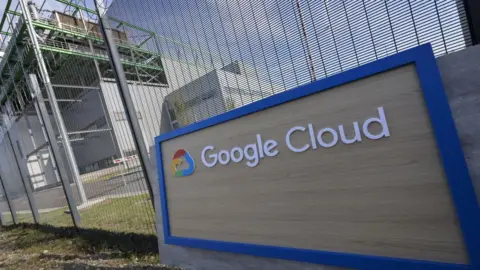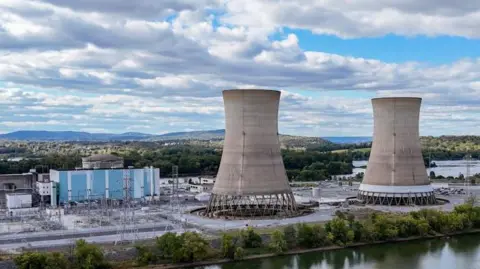What’s the big deal about AI data centres?

2025-09-23 02:10:50
Michael DempseyTechnology Reporter
 Getty Images
Getty ImagesIt’s such a big number that it’s hard to imagine. Worldwide, around $3tn (£2.2tn) will be spent on data centres that support AI between now and 2029.
That estimate comes from the investment bank Morgan Stanley, which adds that roughly half of that sum will go on construction costs, and half on the pricey hardware supporting the AI revolution.
To put that number into perspective, that’s roughly what the entire French economy was worth in 2024.
In the UK alone, it’s estimated that another 100 data centres will be built over the next few years to meet the demand for AI processing.
Some of those will be built for Microsoft which earlier this month announced $30bn (£22bn) investment in the UK’s AI sector.
Just what is it about AI data centres that’s different from the traditional building containing ranks of computer servers that keeps our personal photos, social media accounts and work applications humming away?
And are they worth this terrific spending spree?
Data centres have been growing in size for years. A new term, hyperscale, was coined by the tech industry to describe sites where the power requirement runs into tens of megawatts, before gigawatts, a thousand times bigger than megawatts, came on the scene.
But AI has supercharged this game. Most AI models rely on expensive computer chips from Nvidia to process tasks.
Nvidia chips come in large cabinets costing around $4m each. And these cabinets hold the key to why AI data centres are different.
The Large Language Models (LLMs) that train up AI software have to break language into every possible tiny element of meaning. That is only possible with a network of computers working in unison and in extremely close proximity.
Why is proximity so important? Every metre of distance between two chips adds a nanosecond, one billionth of a second, to the processing time.
It might not sound like much time, but when a warehouse full of computers is whirring away these microscopic delays pile up and dilute the performance needed for AI.
The AI processing cabinets are jammed in together to eliminate this element of latency and create what the tech sector calls parallel processing, operating as one enormous computer. It all spells out density, a magic word in AI construction circles.
Density eliminates the processing bottlenecks that regular data centres see from working with processors sitting several metres apart.
 Bloomberg via Getty Images
Bloomberg via Getty ImagesHowever, those dense ranks of cabinets eat up gigawatts of power and LLM training produces spikes in that appetite for electricity.
These spikes are equivalent to thousands of homes switching kettles on and off in unison every few seconds.
This type of irregular demand on a local grid needs to be carefully managed.
Daniel Bizo of data centre engineering consultancy The Uptime Institute analyses data centres for a living.
“Normal data centres are a steady hum in the background compared to the demand an AI workload makes on the grid.”
Just like those synchronised kettles sudden AI surges present what Mr Bizo calls a singluar problem.
“The singular workload at this scale is unheard of,” says Mr Bizo, “it’s such an extreme engineering challenge, it’s like the Apollo programme.”
Data centre operators are getting around the energy problem in various ways.
Speaking to the BBC earlier this month, Nvidia CEO Jensen Huang said that in the UK in the short term he was hoping that more gas turbines could be used “off the grid so we don’t burden people on the grid”.
He said AI itself would design better gas turbines, solar panels, wind turbines and fusion energy to produce more cost effective sustainable energy.
Microsoft is investing billions of dollars in energy projects, including a deal with Constellation Energy that will see nuclear power produced again on Three Mile Island.
Google, owned by Alphabet, is also investing in nuclear power as part of a strategy to run on carbon-free energy by 2030.
Meanwhile Amazon Web Services (AWS), which is part of the retail giant Amazon, says it is already the single largest corporate buyer of renewable energy in the world.
 Bloomberg via Getty Images
Bloomberg via Getty ImagesThe data centre industry is acutely aware that legislators are keeping an eye on the downsides of AI factories with their intense energy use having a potential impact on local infrastructure and the environment.
One of these environmental impacts includes a hefty supply of water to cool toiling chips.
In the US state of Virginia, home to an expanding population of data centres that keep tech giants like Amazon and Google in business, a bill tying approval of new sites to water consumption figures is under consideration.
Meanwhile a proposed AI factory in northern Lincolnshire in the UK has run into objections from Anglian Water, which is responsible for keeping taps on in the area of the proposed site.
Anglian Water points out that it is not obliged to supply water for non-domestic use and suggests recycled water from the final stage of effluent treatment as a coolant rather than drinking water.
Given the practical problems and enormous costs AI data centres face, is the whole movement really one big bubble?
One speaker at recent data centre conference coined the term “bragawatts” to describe how the industry is talking up the scale of proposed AI sites.
Zahl Limbuwala is a data centre specialist at tech investment advisors DTCP. He acknowledges big questions around the future of AI data centre spending.
“The current trajectory is very difficult to believe. There has certainly been a lot of bragging going on. But investment has to deliver a return or the market will correct itself.”
Bearing these cautions in mind, he still believes AI merits a special place in investment terms. “AI will have more impact than previous technologies, including the internet. So it’s feasible we’ll need all those gigawatts.”
He notes that bragging apart, AI data centres “are the real estate of the tech world.” Speculative tech bubbles such as the dotcom boom of the 1990s lacked a bricks and mortar base. AI data centres are very solid. But the spending boom behind them cannot last forever.





